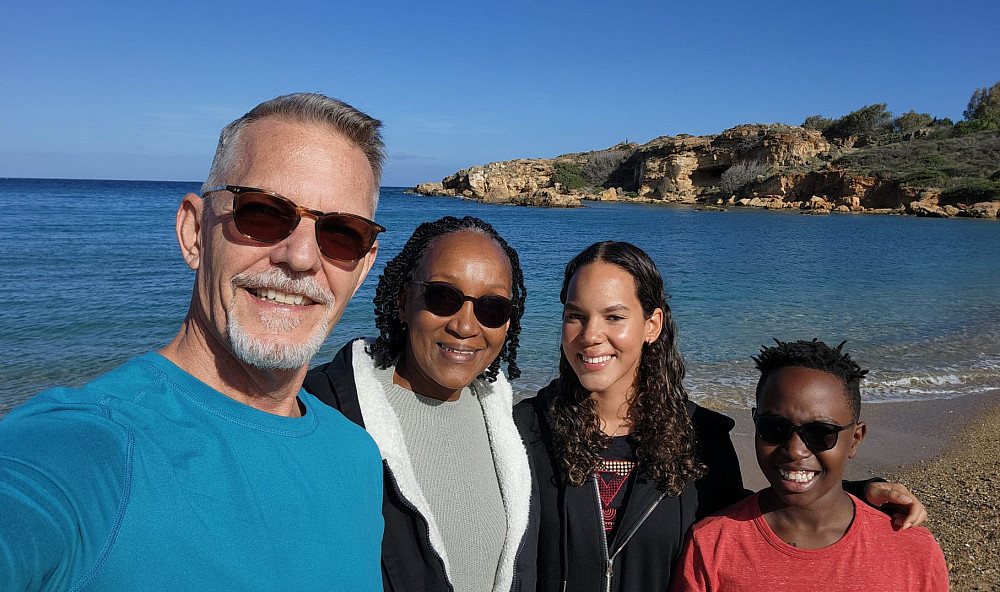main content A Global Career in Humanitarian Development
Charles “Chip” Bury BA ’87 has contributed to international humanitarian and resilience efforts for more than 30 years, with roles that have taken him from Kenya to Kathmandu.

WHO
Charles “Chip” Bury BA ’87
ACADEMICS
BA in international affairs
FIRST POST-L&C JOB
Working as a butcher in Portland’s Yamhill Marketplace
CAREER POSTS
Kenya, Nepal, Uganda
NUMBER OF COUNTRIES VISITED
45
Career Launch:
I grew up in Klamath Falls, Oregon. When I visited the Lewis & Clark campus, I just fell in love. At first, I had no idea about the college’s international programs, but I ended up going to the Soviet Union in 1985, and a lot of my friends went to Kenya. When we reunited, my friends told me, “Chip, you’ve got to go to Kenya after you graduate.” That’s where I set my sights.
In 1988, I did go to Kenya, where I taught English through an organization called WorldTeach. My next job was as an in-country coordinator for Lewis & Clark’s overseas study program to Kenya.
Path to Development Work:
I was connected with the late foreign aid worker Emma McCune, who would later become the second wife to a South Sudanese rebel commander. She was starting an education project called Street Kids International. I helped her raise money for the program in Nairobi. Around this time, I went on holiday to Lamu Island, just off the shore of Kenya. I discovered that the island’s schoolchildren had the worst exam results in the country. A Dutch nonprofit funded my proposal for an education program on the island called School-to-School, and later asked if I would start a regional office in Nairobi.
The problem with these education programs is that it’s difficult to measure results. I reached out to Michael Kremer, who started WorldTeach and is now a development economist at the University of Chicago. He told me the best way to assess a program’s impact is to set up a randomized controlled trial. He encouraged me to secure funding to increase the size and scope for the development side of the program, while he would support the research. Our work snowballed from education to malaria, later expanding into HIV/AIDS and deworming. Kremer would go on to earn a Nobel Prize in Economics for the work we accomplished in Kenya. I feel a huge sense of pride in contributing to the body of knowledge that has now become the gold standard for measuring impact in development programming.
Leveraging ‘Resilience’ in East Africa:
After a handful of other positions, I found myself working as a regional coordinator with USAID. They were starting to work on the concept of resilience. Too often, we keep returning to parts of the world that have recurrent humanitarian disasters and pour a lot of money into them when things go bad. “Resilience” asks if it’s possible to flip that approach on its head and better prepare people for the next shock. We looked at northern Kenya, Ethiopia, Somalia, and parts of southern Sudan. We tried to see how we could share, learn, and build on our experiences to create a sufficient buffer in these communities to withstand the next climactic event. This is work I continued to engage with as a specialist in Nepal.
Current Work in Uganda:
In Uganda, there are 1.5 million refugees who have been displaced from Congo and South Sudan. At USAID, we are trying to create a model that can take refugee populations through a process of “graduation,” where they are given mentoring, skill development, and capital to move toward self-reliance.
Over time, I’ve realized that no one intervention by itself will generate the results we’re looking for. It takes individuals with a variety of different skill sets and technical know-how—whether in agriculture, health, or business development—to come together and collaborate in a meaningful way. The USAID program involves a randomized controlled trial, and I’m pleased that we have data that supports the methods we’re using.
More L&C Magazine Stories
L&C Magazine is located in McAfee on the Undergraduate Campus.
MSC: 19
email magazine@lclark.edu
voice 503-768-7970
fax 503-768-7969
The L&C Magazine staff welcomes letters and emails from readers about topics covered in the magazine. Correspondence must include your name and location and may be edited.
L&C Magazine
Lewis & Clark
615 S. Palatine Hill Road
Portland OR 97219

